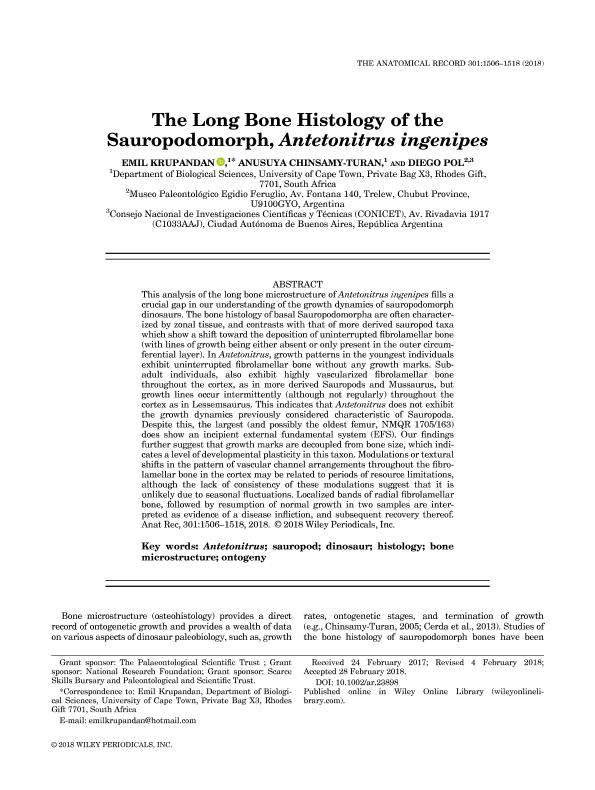Mostrar el registro sencillo del ítem
dc.contributor.author
Krupandan, Emil

dc.contributor.author
Chinsamy, Anusuya

dc.contributor.author
Pol, Diego

dc.date.available
2020-02-20T22:56:21Z
dc.date.issued
2018-09
dc.identifier.citation
Krupandan, Emil; Chinsamy, Anusuya; Pol, Diego; The Long Bone Histology of the Sauropodomorph, Antetonitrus ingenipes; Wiley-liss, Div John Wiley & Sons Inc; Anatomical Record-Advances in Integrative Anatomy and Evolutionary Biology; 301; 9; 9-2018; 1506-1518
dc.identifier.issn
1932-8486
dc.identifier.uri
http://hdl.handle.net/11336/98236
dc.description.abstract
This analysis of the long bone microstructure of Antetonitrus ingenipes fills a crucial gap in our understanding of the growth dynamics of sauropodomorph dinosaurs. The bone histology of basal Sauropodomorpha are often characterized by zonal tissue, and contrasts with that of more derived sauropod taxa which show a shift toward the deposition of uninterrupted fibrolamellar bone (with lines of growth being either absent or only present in the outer circumferential layer). In Antetonitrus, growth patterns in the youngest individuals exhibit uninterrupted fibrolamellar bone without any growth marks. Sub-adult individuals, also exhibit highly vascularized fibrolamellar bone throughout the cortex, as in more derived Sauropods and Mussaurus, but growth lines occur intermittently (although not regularly) throughout the cortex as in Lessemsaurus. This indicates that Antetonitrus does not exhibit the growth dynamics previously considered characteristic of Sauropoda. Despite this, the largest (and possibly the oldest femur, NMQR 1705/163) does show an incipient external fundamental system (EFS). Our findings further suggest that growth marks are decoupled from bone size, which indicates a level of developmental plasticity in this taxon. Modulations or textural shifts in the pattern of vascular channel arrangements throughout the fibrolamellar bone in the cortex may be related to periods of resource limitations, although the lack of consistency of these modulations suggest that it is unlikely due to seasonal fluctuations. Localized bands of radial fibrolamellar bone, followed by resumption of normal growth in two samples are interpreted as evidence of a disease infliction, and subsequent recovery thereof.
dc.format
application/pdf
dc.language.iso
eng
dc.publisher
Wiley-liss, Div John Wiley & Sons Inc

dc.rights
info:eu-repo/semantics/openAccess
dc.rights.uri
https://creativecommons.org/licenses/by-nc-sa/2.5/ar/
dc.subject
ANTETONITRUS
dc.subject
BONE MICROSTRUCTURE
dc.subject
DINOSAUR
dc.subject
HISTOLOGY
dc.subject
ONTOGENY
dc.subject
SAUROPOD
dc.subject.classification
Paleontología

dc.subject.classification
Ciencias de la Tierra y relacionadas con el Medio Ambiente

dc.subject.classification
CIENCIAS NATURALES Y EXACTAS

dc.title
The Long Bone Histology of the Sauropodomorph, Antetonitrus ingenipes
dc.type
info:eu-repo/semantics/article
dc.type
info:ar-repo/semantics/artículo
dc.type
info:eu-repo/semantics/publishedVersion
dc.date.updated
2020-02-18T16:14:55Z
dc.journal.volume
301
dc.journal.number
9
dc.journal.pagination
1506-1518
dc.journal.pais
Estados Unidos

dc.journal.ciudad
Hoboken
dc.description.fil
Fil: Krupandan, Emil. University of Cape Town; Sudáfrica
dc.description.fil
Fil: Chinsamy, Anusuya. University of Cape Town; Sudáfrica
dc.description.fil
Fil: Pol, Diego. Museo Paleontológico Egidio Feruglio; Argentina. Consejo Nacional de Investigaciones Científicas y Técnicas; Argentina
dc.journal.title
Anatomical Record-Advances in Integrative Anatomy and Evolutionary Biology

dc.relation.alternativeid
info:eu-repo/semantics/altIdentifier/doi/http://dx.doi.org/10.1002/ar.23898
dc.relation.alternativeid
info:eu-repo/semantics/altIdentifier/url/https://anatomypubs.onlinelibrary.wiley.com/doi/full/10.1002/ar.23898
Archivos asociados
